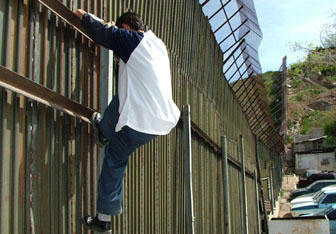 |
 |
 |
 Editorials | February 2007 Editorials | February 2007  
Border Fence - The Cost is Far Too High
 Stewart A. Alexander - Peace and Freedom Party Stewart A. Alexander - Peace and Freedom Party


| | A man tries to climb the border wall separating Mexico and the United States. (AP) |
A study released last December by the non-partisan Congressional Research Service says a proposed 700 mile stretch of fence, along the 2,000 mile U.S. – Mexico border, could cost an estimated $49 billion.

But what the report fails to say, U.S. –built walls on the border would cost both the U.S. and Mexico trillions of dollars in economic losses over the predicted 25-year lifespan of the fence, and non-monetary damage to political and cultural relations between the two countries would also last for decades.

Today immigrants play an essential role in the economies of the U.S. and Mexico. The most outstanding benefit to the U.S. economy includes the ability of farmers to secure peak-season labor essential to key crops, and the availability of sufficient labor in construction and light industry in California and at least 15 other states. The difficulty in obtaining sufficient labor (at any labor cost) has already seriously damaged many farms and industrial firms during the last year, as anti-immigrant agitation and government raids have reduced the labor supply in many areas.

In California’s agricultural industry migrant workers make up about 45 percent of the workforce. Recently a Texas study reported that undocumented immigrants were a net benefit to the Texas economy, looking at gross state product, revenues generated, taxes paid and the cost of state services.

Over the past 25 years U.S. businesses have enjoyed the benefits of immigrants available first for cheap basic labor, and later for labor in higher-paying industries as well. The previous advantage to employers that undocumented immigrants could be intimidated into staying out of unions has declined as their importance in the economy has increased.

Federal laws written to punish employers and individuals hiring undocumented immigrants were largely ignored nation-wide for the last 20 years. Their recent very public enforcement in a few cases, in response to anti-immigrant campaigns, has already created problems for many employers, as well as for immigrant workers. While replacement labor is available in some cities, in many areas an insufficient workforce has caused delays in construction and industrial work, and spoiled crops.

The North American Free Trade Agreement, or NAFTA, was sold as a way to benefit the economies of both the U.S. and Mexico; however NAFTA has been a failure from its inception for the working class, and only benefited an already-wealthy few. It has never benefited the masses of working people in either country.

The majority of the hundreds of thousands that are crossing the border are doing so to obtain work and to provide for their families. There is mass unemployment, poverty and hunger just south of the border. A laborer will earn $6 to $7 a day in Mexico as compared to a laborer earning $60 to $70 a day in the U.S., or substantially more in some areas and in union jobs. Thanks in part to NAFTA, prices on the Mexican side are no longer far lower than north of the border. Whatever the laws and however they are enforced, the hunger in Mexico makes emigration the only option for many workers.

Another major problem with NAFTA was that it overruled traditional and legal protections in the agrarian culture of Mexico, leading to the collapse of several sections of Mexican agriculture and an increase in the importation of key elements of the Mexican diet. Agricultural unemployment became an epidemic that ravaged valley after valley. An agreement that helped develop instead of devastate Mexican agriculture would have benefited Mexico in world markets and would have provided work for millions.

Any attempts to stem the flow of immigration by building walls will never succeed while the irresistible economic facts dictate emigration for unemployed Mexican workers. Even so, an attempt to secure the entire border will cost several times the estimates $49 billion in the CRS report, as the fence voted by Congress only covers one-third of a long border.

Effectively addressing the issues of immigration and prosperity in the U.S. and Mexico will require negotiations that address the needs of the working class on both sides of the border. Economic security and the protection of labor rights in both countries, along with environmental protection and the recognition of the rights of immigrants, will be needed for any agreement to work for the benefit of both countries.

For more information search the Web for Stewart A. Alexander; PFP Setting Tone For 2008; and Immigrants Are Lost in American Politics. | 
 | |
 |



